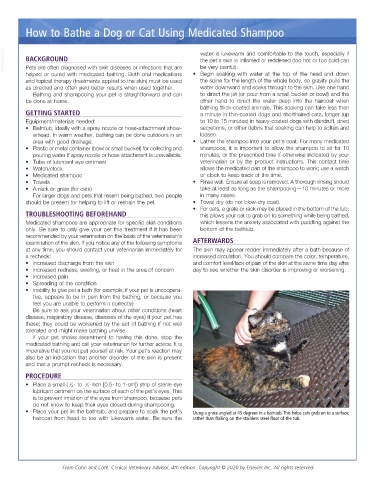Page 3170 - Cote clinical veterinary advisor dogs and cats 4th
P. 3170
How to Bathe a Dog or Cat Using Medicated Shampoo
VetBooks.ir BACKGROUND water is lukewarm and comfortable to the touch, especially if
the pet’s skin is inflamed or reddened (too hot or too cold can
be very painful).
Pets are often diagnosed with skin diseases or infections that are
helped or cured with medicated bathing. Both oral medications • Begin soaking with water at the top of the head and down
and topical therapy (treatments applied to the skin) must be used the spine for the length of the whole body, so gravity pulls the
as directed and often yield better results when used together. water downward and soaks through to the skin. Use one hand
Bathing and shampooing your pet is straightforward and can to direct the jet (or pour from a small bucket or bowl) and the
be done at home. other hand to direct the water deep into the haircoat when
bathing thick-coated animals. This soaking can take less than
GETTING STARTED a minute in thin-coated dogs and shorthaired cats, longer (up
Equipment/materials needed: to 10 to 15 minutes) in heavy-coated dogs with dandruff, dried
• Bathtub, ideally with a spray nozzle or hose-attachment show- secretions, or other debris that soaking can help to soften and
erhead. In warm weather, bathing can be done outdoors in an loosen.
area with good drainage. • Lather the shampoo into your pet’s coat. For many medicated
• Plastic or metal container (bowl or small bucket) for collecting and shampoos, it is important to allow the shampoo to sit for 10
pouring water if spray nozzle or hose attachment is unavailable. minutes, or the prescribed time if otherwise indicated by your
• Tube of lubricant eye ointment veterinarian or by the product instructions. This contact time
• Watch/clock allows the medicated part of the shampoo to work; use a watch
• Medicated shampoo or clock to keep track of the time.
• Towels • Rinse well. Ensure all soap is removed. A thorough rinsing should
• A rack or grate (for cats) take at least as long as the shampooing—10 minutes or more
For larger dogs and pets that resent being bathed, two people in many cases.
should be present for helping to lift or restrain the pet. • Towel dry (do not blow-dry coat).
• For cats, a grate or rack may be placed in the bottom of the tub;
TROUBLESHOOTING BEFOREHAND this allows your cat to grab on to something while being bathed,
Medicated shampoos are appropriate for specific skin conditions which lessens the anxiety associated with paddling against the
only. Be sure to only give your pet this treatment if it has been bottom of the bathtub.
recommended by your veterinarian on the basis of the veterinarian’s
examination of the skin. If you notice any of the following symptoms AFTERWARDS
at any time, you should contact your veterinarian immediately for The skin may appear redder immediately after a bath because of
a recheck: increased circulation. You should compare the color, temperature,
• Increased discharge from the skin and comfort level/lack of pain of the skin at the same time day after
• Increased redness, swelling, or heat in the area of concern day to see whether the skin disorder is improving or worsening.
• Increased pain
• Spreading of the condition
• Inability to give pet a bath (for example, if your pet is uncoopera-
tive, appears to be in pain from the bathing, or because you
feel you are unable to perform it correctly)
Be sure to ask your veterinarian about other conditions (heart
disease, respiratory disease, diseases of the eyes) if your pet has
these; they could be worsened by the act of bathing if not well
tolerated and might make bathing unwise.
If your pet shows resentment to having this done, stop the
medicated bathing and call your veterinarian for further advice. It is
imperative that you not put yourself at risk. Your pet’s reaction may
also be an indication that another disorder of the skin is present
and that a prompt recheck is necessary.
PROCEDURE
• Place a small ( 1 4 - to 1 2 -inch [0.5- to 1-cm]) strip of sterile eye
lubricant ointment on the surface of each of the pet’s eyes. This
is to prevent irritation of the eyes from shampoo, because pets
do not know to keep their eyes closed during shampooing.
• Place your pet in the bathtub, and prepare to soak the pet’s Using a grate angled at 45 degrees in a bathtub. This helps cats grab on to a surface,
haircoat from head to toe with lukewarm water. Be sure the rather than flailing on the stainless steel floor of the tub.
From Cohn and Côté: Clinical Veterinary Advisor, 4th edition. Copyright © 2020 by Elsevier Inc. All rights reserved.

